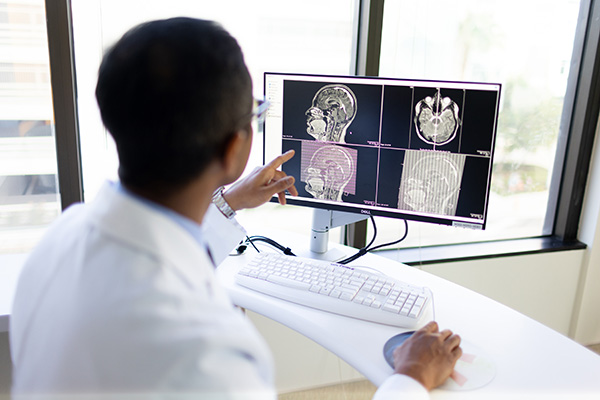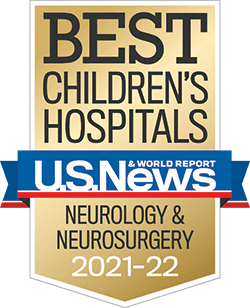Pediatric Cerebrovascular Disease
We know a diagnosis of cerebrovascular disease can be overwhelming for your child and your family. The experts at the CHOC Neuroscience Institute are trained to provide specialized, comprehensive care for kids, and will be with your family from diagnosis through your child’s treatment.

A Multidisciplinary Team
Your child’s dedicated care team includes neurology, neurosurgery, neuro-interventional radiology, radiology, physical medicine and rehabilitation, hematology and psychology specialists all working to provide your family comprehensive care before, during and after diagnosis and treatment. They will also be with you in managing your child’s condition over time.
What is Cerebrovascular Disease?
Cerebrovascular disease, also called neurovascular disease, refers to a group of disorders that affect the flow of blood to the brain. In these disorders, the brain may not be able to get enough oxygen and nutrients due to limited blood supply. In some cases, there may be bleeding in the brain that also disrupts the blood flow.
Types of Cerebrovascular Disease in Children
While cerebrovascular disease in children is rare, below are some types of cerebrovascular disease that can occur:
- Aneurysm: A weakening of the artery wall causing an enlargement of the artery, resulting in an abnormal bulge. Aneurysms can be dangerous because there is risk of them bursting, which can cause serious problems and death.
- Stroke: Sudden neurological symptoms caused by an interruption of blood flow due to a blocked or burst blood vessel in the brain. This causes a lack of oxygen and nutrients which may result in the death of brain cells. In children, strokes usually occur due to abnormalities in the blood vessels (arteriopathy), heart disease or infections.
- Stenosis: The narrowing of a blood vessel that may lead to decreased blood flow to the brain.
- Transient Ischemic Attack (TIA): A temporary period of symptoms similar to stroke, often referred to as a mini stroke. TIA symptoms last less than 24 hours, do not cause permanent damage and can be a warning sign of a larger stroke.
- Moyamoya Disease: A rare disorder that affects the large arteries at the base of the brain. The arteries become narrowed, reducing blood flow. To try to supply blood to the brain, tiny blood vessels develop at the base. Moyamoya disease can cause TIA, stroke and seizures. The disease progresses over time, so early diagnosis is vital.
- Arteriovenous Malformations (AVMs): Arteries and veins in the brain are tangled and connected, potentially obstructing blood flow and lowering the amount of oxygen and nutrients that reach the brain. AVMs may rupture and cause bleeding in the brain. In some cases, AVMs are discovered at birth, while other times they are diagnosed after an event like a stroke or seizure.
- Developmental Venous Anomalies (DVAs): Unusual vein formations, particularly small veins. The small veins drain into a larger vein and are most often found in the brain. People are born with this condition, which generally does not cause symptoms and requires no treatment. DVAs are not dangerous.
- Cavernous Malformation: Abnormal clusters of tiny and enlarged blood vessels with pockets of blood. They can occur in the brain, spinal cord or the nerves of the skull. They may cause no symptoms, but in some cases can bleed or form blood clots that lead to seizures or other neurological symptoms.
- Capillary Telangiectasia: A group of abnormally large capillaries in the brain. They rarely cause symptoms and by themselves are typically insignificant.
Causes of Cerebrovascular Disease in Children
There are several causes of cerebrovascular disease in children, including genetic and acquired causes. Common causes include:
- Arteriopathy: Abnormalities in the arteries of the brain that may be due to inflammation, tearing of the wall of an artery (dissection) or other causes.
- Arterial Thrombosis: When a blood clot forms in the brain and can cause a stroke.
- Embolus (embolic stroke): When a blood clot forms anywhere in the body (most often in the heart) and travels to the brain, blocking blood flow.
- Cerebral Venous Thrombosis: When a blood clot forms in the brain’s venous sinuses, preventing blood from draining from the brain.
- Atherosclerosis: The hardening and narrowing of arteries due to plaque buildup, blocking blood flow. This is uncommon in children but is a common cause of cerebrovascular disease in adults.
What are the Symptoms of Cerebrovascular Disease in Children?
Depending on the condition, symptoms can vary. Common symptoms of cerebrovascular disease are:
- Dizziness
- Vomiting
- Neck Pain or Stiffness
- Headache
- Weakness on one side of the body
- Numbness on one side of the body
- Seizures
- Slurring or loss of speech
- Problems with vision or coordination
- Confusion
- Loss of consciousness
To determine if your child is having a stroke, remember the acronym B.E.F.A.S.T. and watch for these signs:
-
B: Balance changes
E: Eye/vision changes
F: Facial drooping
A: Arm or leg weakness
S: Speech difficulties
T: Time – make note of the time symptoms started and seek medical attention immediately!
How are Cerebrovascular Diseases Diagnosed?
There are a range of diagnostic tools used to diagnose cerebrovascular diseases.
- CT Scan: Using advanced x-ray imagery, these scans can provide highly detailed images of the brain and blood vessels quickly.
- MRI: MRIs use magnetic field and computer-generated radio waves to view internal body structures thoroughly.
- Magnetic Resonance Angiography (MRA): A type of MRI that looks specifically at the blood vessels.
- Cerebral Angiogram: Using a catheter, a special dye is injected into the blood vessels through an artery in the leg. This produces images of the arteries in the brain to check for signs of blockage or bleeding. This technique may be used to treat certain disorders as well.
- CT Angiogram: This test uses CT technology with a special dye to produce highly detailed images of the arteries.
- Echocardiogram (ECHO): These are used to assess the hearts’ structure and function through an ultrasound using ultrasonic sound waves.
- Transcranial Doppler (TCD): This is an ultrasound to detect problems that affect the blood flow in your brain like blood clots and narrow blood vessels.
- Electroencephalogram (EEG): This test uses small electrodes attached to the scalp to detect abnormalities in the brain’s function and evaluate for seizures.
- Blood Tests: Various blood tests can be done to determine if your child has a clotting disorder, infection or inflammation.
- Fetal Medicine: Fetal diagnostics at the Fetal Care Center of Southern California can allow for diagnosis before birth in some cases and plan for treatment if needed.
Treatment for Cerebrovascular Disease
Treatment will vary depending on the type of cerebrovascular disease and the severity. Your child’s care team may include members from the CHOC neurology, neurosurgery, neuro-interventional radiology, radiology, physical medicine and rehabilitation, hematology and psychology teams working together to provide the most comprehensive care possible.
Some common treatments for cerebrovascular diseases in children include:
- Monitoring: In some cases, a malformation may not be causing a serious issue, so it is best to regularly monitor it for any changes.
- Fetal Treatment Planning: If your baby is diagnosed with a cerebrovascular condition before birth, the Fetal Care Center of Southern California will provide a comprehensive plan for treatment of your baby’s condition after birth.
- Medication: Depending on the condition, medications can be prescribed. For example, if your child has suffered from a stroke, they could be prescribed medication to prevent stroke recurrence, such as aspirin.
- Lifestyle modification: Certain cerebrovascular conditions may be treated or optimized with lifestyle modifications such as good hydration, diet and exercise.
- Thrombectomy: If an artery is blocked by a blood clot within the brain, thrombectomy may be done to reestablish blood flow. In this minimally invasive technique, a catheter is inserted to remove the blood clot from the artery.
- Neurovascular surgery: The location of a malformation plays a key part in determining if surgery is needed. Surgeries may be open, minimally invasive or endovascular. Open surgery refers to traditional surgery by cutting skin and tissues to access an internal part of the body. If a malformation is too deep or close to vital nerve pathways, minimally invasive surgery could be the best approach. If the condition is specific to arteries and/or veins, endovascular surgery may be used. Read more about CHOC’s Pediatric Neurosurgery Program.
Recovery for Children with Cerebrovascular Disease
Recovery can look different for each child and includes a wide range of services for cerebrovascular diseases. Depending on the specific condition, there may be long-term effects on development. Rehabilitation can help children reach their full potential and regain abilities needed for daily life. Learn more about Rehabilitation Services at CHOC.
In some cases, impairment may be permanent, and rehabilitation will not be the best course of action. In these cases, recovery may include palliative care and mental health services to help the family learn how to live with and address their child’s medical needs.
Why CHOC?
As a parent, your top priority is choosing a hospital and team of doctors who can provide the best outcome for your child and your family. The CHOC Neuroscience Institute is a place dedicated to caring for kids with complex and rare medical issues. Our specialists have devoted their training, research and practice to caring specifically for children.
- We practice a team approach to healing. Neurological conditions in children require a team of caregivers including neurologists, orthopedic specialists, nurses, social workers, rehabilitation therapists and more. Our team works together on every aspect of your child’s care from diagnostics to surgery and follow-up care.
- We care about your child deeply, and will care for the whole family. We make the experience seamless, from coordinating care, communicating with your child’s primary care physician, or discussing your child’s treatment with your family as long as you need to get all of your questions answered. CHOC is here for you.
- We understand that a hospital can seem frightening for both the child and their family. Our child life specialists work with families to “normalize” hospital equipment and procedures so you can concentrate on healing instead.
- Our surgical center is outfitted with advanced imaging, communication and robotics technologies, specific to children and their needs. This ensures a high level of skill and safety for the children under our care.













